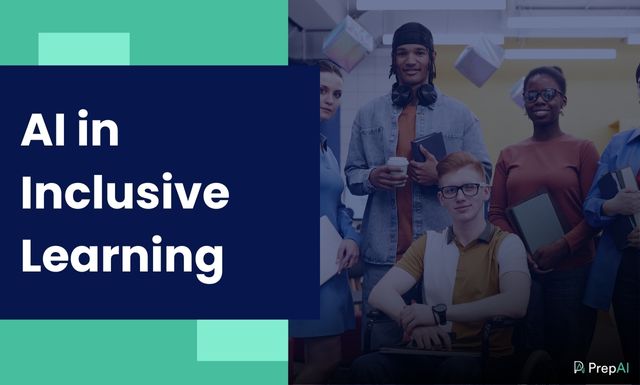Inclusive learning is no longer a concept found only on papers. Artificial intelligence is making inclusive learning a reality and helping the world embrace diversity. The blog talks of the role played by AI in the educational sector, especially w.r.t inclusive learning.
Artificial intelligence and machine learning are now the key growth factors in various industries including education. The use of technology is making inclusive learning a reality. One example is that the use of technology is making inclusive learning a reality. But what is inclusive learning?
Students with disabilities, language barriers, cultural differences, etc., can be a part of the same classrooms and taught along with the rest of the class instead of being separated or marginalized due to lack of a common ground. Artificial intelligence is making great headway in the education industry and bridging the gap between students and educators.
Based on a report by eLearning Industry, close to 50% of the learning management platforms will be powered by AI in just 3 years from now. The Covid-19 pandemic in 2020 has boosted online learning. With more schools, colleges, and educational institutions relying on technology to impart education, the need for AI/ML software applications has also increased. According to another survey, 85% of educators feel that AI technology will be an integral part of education.
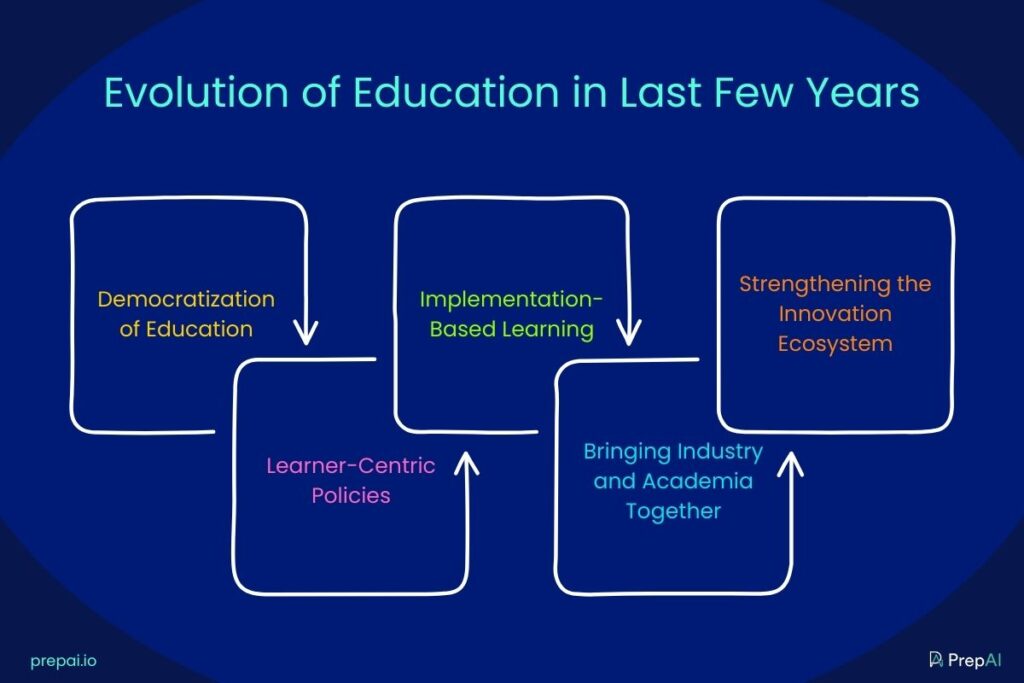
Inclusive learning – A Concept
Social, political, and technological aspects have brought forth a vital flaw in the education industry. The lack of inclusivity became a glaring sign of error that needs to be corrected as soon as possible. Luckily, inclusive learning is becoming a reality one step at a time.
What is Inclusive Learning?
It’s no secret that students have varying learning styles and personalities. Some are confident, while others are tentative. Some students have learning and speaking disabilities. A few have physical disabilities. Language, comprehension, economy, etc., are common barriers that make it difficult for some students to learn and compete with others. Neurodiverse (ND) and Special Educational Needs and Disabilities (SEND) students have difficulties in learning through conventional methods. Each of these students has specific needs that influence learning abilities and patterns. This is why special schools have been set up for students with special needs. However, this, too, comes with quite a few challenges. The students continue to be marginalized and treated differently and even bullied by others for not being ‘normal’.
Inclusive learning aims to bridge these gaps and create an environment where a student with different abilities can learn in the same classroom, that too, without compromising on the quality of education. It tries to create a holistic environment where students with special needs can confidently learn alongside others without being subject to negative emotions. Inclusive learning can take personalized learning to the next level as it aims to be proactive and create a classroom where the lessons, activities, etc., can be performed by anyone before these are adjusted to suit individual students’ needs. Both approaches are equally important and necessary.
This is easier said than done.
However, thanks to technology, inclusive learning is steadily gaining momentum in different parts of the world.
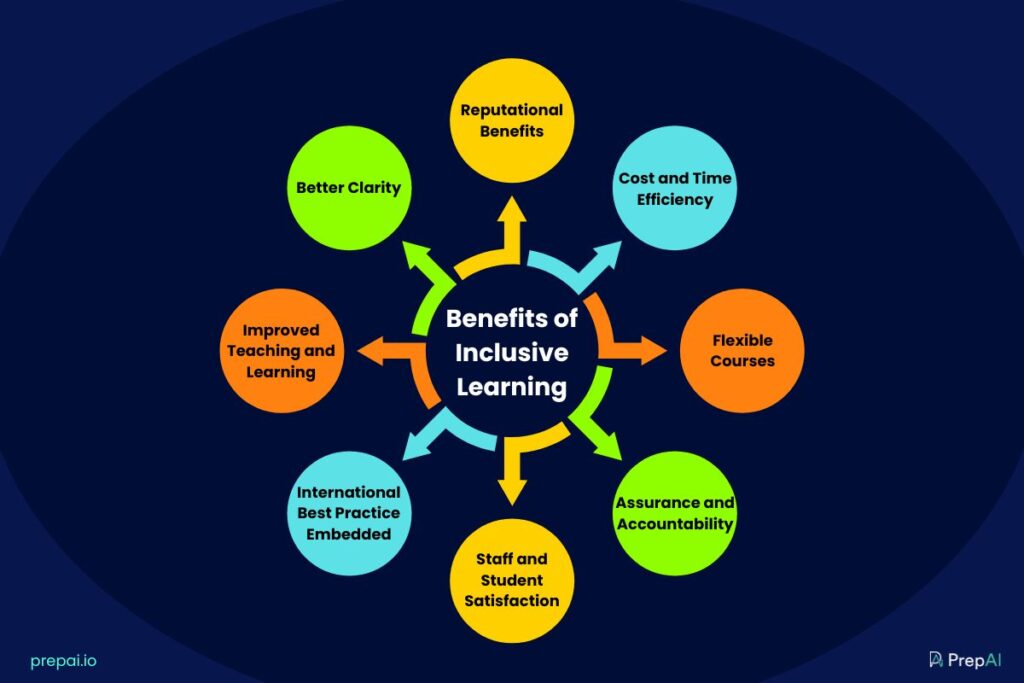
Why is the World Pushing Towards Inclusive learning?
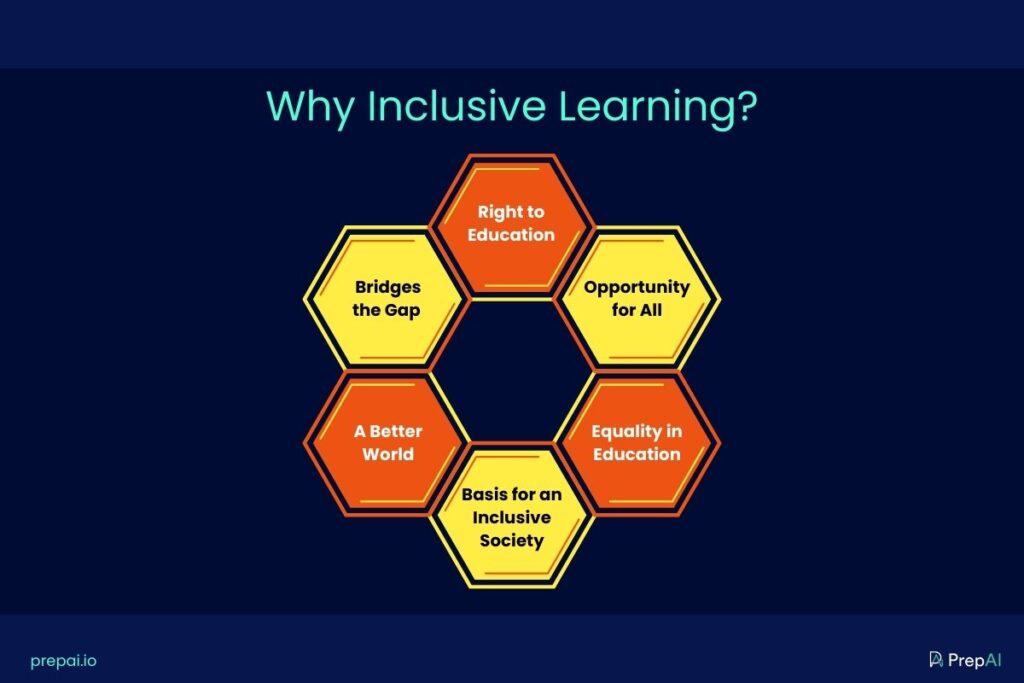
Bridges the Gap
The world needs inclusive learning because it bridges the gap between students by working on the differences (region, societies, value systems, beliefs, etc.) that set them apart from one another. This gives everyone a good chance to shine and prove their worth. Instead of being reactive about how to cover the differences, it presents a situation where all students can participate in learning in the same environment. Inclusive learning lays the foundation for everyone to gain and do something on a common platform.
Right to Education
Every person in this world has the right to education. The lack of access to facilities or personal beliefs should not come in the way of educating a student. Inclusive learning helps students leverage their right to education. In a world where marginalized communities have been ignored for decades, inclusive learning tries to right the wrong by building an environment that meets their requirements while also catering to the ‘majority’.
Opportunity for All
What is AI in Special Education? Students with special needs have to be made a part of the social activities and presented with the same opportunities as others. It’s when people with intellectual and physical disabilities are given a chance to perform and prove their worth that we can create a holistic learning environment that promotes equality. Individualized learning focuses on areas of improvement to help students with special needs to compete with others.
Equality in Education
Though we are far from achieving equality among humans, we can make it happen by bringing equality to education. The aim is to provide equal rights to students from different backgrounds and abilities to help them achieve success. Inclusive education changes the existing standards by initiating a more universal approach. For example, when creating course content, teachers look for materials that can be beneficial to every student and structure the lessons to incorporate all of them. Multimedia (images, videos, audio, etc.) will play a major role in designing inclusive classrooms.
The Basis for an Inclusive Society
When children learn to be more inclusive, they’ll grow up to create an inclusive society for others. Diversity and inclusivity are being given more prominence to make students understand that everyone is different and needs to be respected. Inclusive classrooms go a long way in preparing children to become assertive and empathic individuals. When you start training the young ones to respect people and accept their differences, you make them more tolerant and open to diversity. It also widens their perspectives and prevents them from disliking anyone who doesn’t agree with their views.
A Better World
When children grow up understanding diversity, the world will naturally be a better place. Racism, cultural appropriation, and religious hatred will no longer cause humans to harm one another. Inclusivity at a young age leads to adults with more awareness. While this sounds utopist, it is not impossible to encourage and build a better new generation with more compassion and understanding about others. And inclusive classrooms have a crucial role in nudging young minds in the right direction.
What is the Role of Technology in Inclusive Education?
Custom-made solutions are the only way to train students with special needs as the types of disabilities are too varied to create a one-for-all solution. The aim of using technology in inclusive learning is to reduce the feeling of dependence. The course is charted in a way to make students more independent and rely less on the educator. This makes them feel confident to tackle situations on their own. Moreover, students tend to know what they are good at and how they prefer to learn. Providing these options in the classrooms will make it easier for them to display their strengths.
A few examples of how technology can help in inclusive education are listed below:
- Speech recognition technology makes it possible for students with special needs to record the lessons or convert handwritten text to speech.
- Augmentative communication and speech therapy classes are conducted online to help kids with speaking disabilities compete with other students in the classroom.
- AI-based translators assist students to bridge the gap between two or more languages. Students can learn in a language they understand.
- Students can rely on web-based learning and online classes to overcome geographical and distance barriers.
- Students who speak minority languages can use AI-based translation apps to understand the lessons in their native tongue.
- Students with visual disabilities can learn through text-to-speech conversions, while those with hearing difficulties can benefit from the visual representation (PPT, AR/ VR devices, etc.).
How AI is contributing to Inclusive Learning
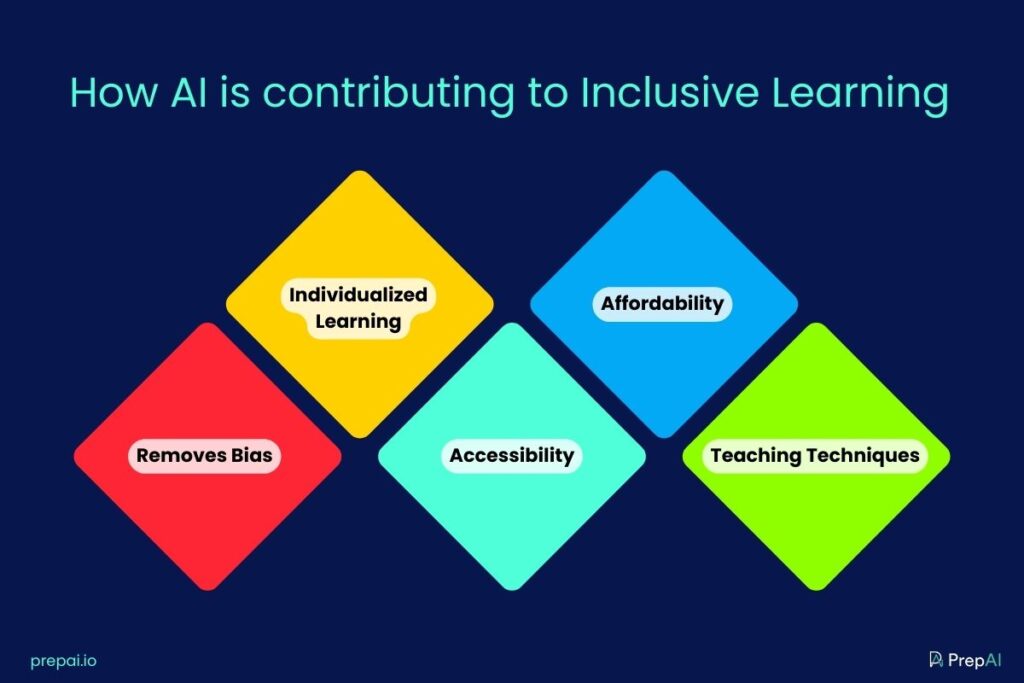
1. Removes Bias
Human bias is an inherent part of our society. Artificial intelligence can help reduce and remove bias that comes in the way of the teacher-student relationship, especially when either of them belongs to different cultures, races, regions, etc. However, we need to ensure that the data fed into the AI systems are not biased.
2. Individualized Learning
AI eLearning platforms have been personalizing the content and the speed of training to suit the students. AI makes it easier for students with special needs to learn at their own pace without feeling stressed out. It can also convert the content into different formats suitable for each student.
3. Accessibility
Technology makes it possible for children from remote areas to access education which wasn’t possible during the earlier days. Even if there are no schools/ colleges in the area, children can still continue their education through eLearning apps. For example, MOOC (Massive Open Online Course) is a model that delivers online content and learning opportunities to anyone who wants to learn irrespective of physical attendance.
4. Affordability
The advent of AI is gradually reducing the cost of education. Students can apply for online courses and certifications that are cost-effective and provide the same quality of education. This helps students from highly diverse backgrounds to have a chance at education. Those who cannot attend colleges and universities can also learn by joining online courses that cost less and fit their budget.
5. Teaching Techniques
Artificial intelligence is also helping teachers understand ways to teach students with special needs. AI in inclusive learning assists teachers to identify the right method of teaching and the right channel of communication to interact with a student from a different background. The aim is to change how teachers perceive learning by making them proactive instead of reacting to the situation.
Key Application Areas of AI for Inclusive Learning
AI has a significant impact on making education more inclusive and accessible for all learners, including those with disabilities or diverse learning needs. Here are some key applications:
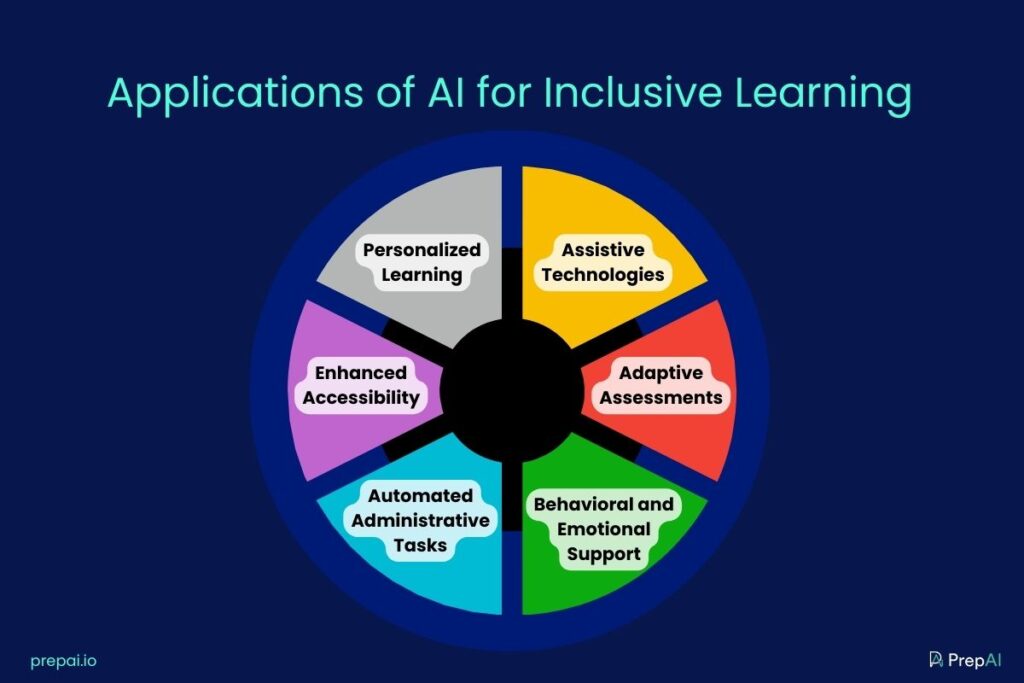
1. Personalized Learning
AI can tailor educational content to meet individual student needs, providing customized learning experiences that adapt to each student’s pace and style. Personalized learning focuses on reducing the differences, while inclusive learning uses the differences to create a common ground for students. Both work in tandem and support each other to offer a safe and creative learning environment.
2. Assistive Technologies
AI-powered tools like text-to-speech, speech-to-text, and real-time transcription services help students with visual or hearing impairments access educational materials more easily. Generative AI has further enhanced the role of assistive technologies by quickly creating content to suit the diverse needs of students.
3. Adaptive Assessments
AI can create assessments that adjust in real-time based on a student’s performance, ensuring that the difficulty level is appropriate and providing immediate feedback. Moreover, teachers don’t have to spend hours creating test papers and quizzes. Online assessment tools like PrepAI can automatically convert input data into tests with lower-order and higher-order thinking questions that test the various abilities of the students.
4. Behavioral and Emotional Support
AI systems can analyze student data to identify those who might need additional emotional or behavioral support, helping educators intervene early and provide necessary assistance. Furthermore, knowing that students with special needs can rely on technology to compete with others gives them confidence to prove their worth and excel in the fields of their choice.
5. Automated Administrative Tasks
AI can handle routine tasks like grading and scheduling, freeing up teachers to focus more on personalized instruction and student engagement. An inclusive classroom needs more groundwork and effort from the school management and teachers. This increases their load and can put extra stress on them. Fortunately, AI can handle the additional work if you make an informed decision about streamlining the admin tasks.
6. Enhanced Accessibility
AI can provide real-time captioning and translation services, making it easier for students who speak different languages or have hearing impairments to participate in class. Accessibility is not limited to the physical arena, though that is definitely the foremost aspect to consider. Every part of the learning process can be made accessible to students when you build a holistic and inclusive classroom.
These applications not only support students with disabilities but also enhance the overall learning experience for all students by making education more flexible, responsive, and inclusive.
Benefits of Inclusive Learning
Implementing comprehensive inclusive learning strategies in educational institutions can have multiple benefits for management, students, parents, and society as a whole.
Openness to Change/ Acceptance
When children are exposed to different lifestyles, cultures, physical appearances, and limitations from a young age, they easily accept the diversity present in our world. Instead of being influenced by the rigid standards of what’s considered normal, beautiful, or correct, they will learn that being different doesn’t automatically mean wrong or bad. It also prepares everyone to accept each other and be open to changes.
Diverse Perspectives
Inclusive classrooms facilitate real-time discussions about how different people perceive the same events or details. For example, students from the land can have meaningful discussions with immigrants about cultural differences, bullying, adjustments, etc. Moreover, they can see that the same event means different things to different people. For example, the US-Vietnam War focuses on the Americans in the US and shows the Vietnamese side in their country. When students from both backgrounds meet in an inclusive classroom, they can learn and see things from others’ perspectives.
Greater Interaction
While schools for kids with special needs have helped them to an extent, this process also alienated them from the mainstream. When children don’t know or meet others with special needs there’s a risk of them being uncompassionate and ableist. This leads to bullying, hatred, stigma, etc., about people with special needs and can harm them in many ways. An inclusive classroom brings them together and creates a space for the students to personally interact with each other. They can see and learn for themselves through experience rather than believe what they are told.
Positive Attitude
Everyone involved will develop a positive attitude in life and benefit from the unified approach. Those lacking confidence will find their worth and identify their strengths. There will be more social interaction and peer-to-peer learning, which can directly increase their academic performance. It also brings out the best in everyone and helps them work together as a team. All these traits will help them in their personal and professional lives.
Case Study: AI in Inclusive Education in Japan
A recent study titled “Challenges and opportunities of AI in inclusive education: a case study of data-enhanced active reading in Japan” delves into the integration of AI in inclusive education, focusing on how it can support diverse learners, including those with special needs.
Key Insights:
Objective
The study aimed to explore the potential and challenges of using AI to enhance inclusive education, where students with varying needs learn together.
Methodology
Researchers utilized the Learning and Evidence Analysis Framework (LEAF), a learning analytics-enhanced environment, to monitor and analyze students’ learning behaviors during an active reading task. This involved tracking learning logs of two students in a resource room setting.
Findings
Learning Behaviors
The study identified specific learning behaviors from the logs, providing insights into how students interact with the AI-enhanced learning environment.
Challenges
One of the main challenges was orchestrating multiple flows of information and tasks in a diverse learning context.
Opportunities
AI demonstrated potential in offering personalized support and adapting to individual learner needs, thereby enhancing the effectiveness of inclusive education.
Human Involvement
The research highlighted the crucial role of human involvement in managing and facilitating AI-driven educational practices to ensure they cater to the diverse needs of all learners.
This study underscores the significant role AI can play in creating more inclusive educational environments, while also addressing the inherent challenges.
Conclusion
Be it Duolingo, PrepAI, or other AI-based platforms, artificial intelligence is becoming the core of the education industry. Teachers, students, and establishments will continue to rely more on advanced technology to create a better and student-centric learning environment.
Edtech consulting companies have a crucial role to play in this scenario. Educational institutions and eLearning platforms find it cost-effective to work with solution providers and customize AI software to suit their requirements. It’s time to embrace the changes AI brings education and take inclusive learning to every corner of the world.




